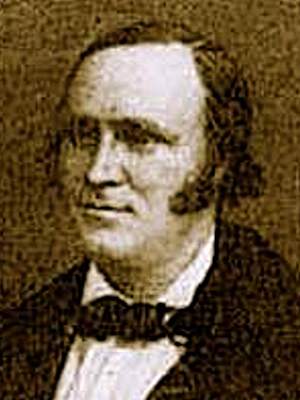Amasa M. Lyman
Born March 30, 1813, in Lyman, New Hampshire, Amasa Mason Lyman was baptized a member of The Church of Jesus Christ of Latter-day Saints at the age of 19. Following his baptism, Amasa traveled to Palmyra, New York, hoping to meet the Prophet Joseph Smith, only to discover that the main body of the Church had already moved to Ohio by that time. Lyman made his way to Ohio, and to the Johnson farm where he met John Johnson, the father of the missionary, Lyman E. Johnson, who had baptized him.
Upon his first meeting with the Prophet Joseph Smith, Amasa remarked, “Of the impressions produced I will here say although there was nothing strange or different from other men in his personal appearance, yet when he grasped my hand in that cordial way (known to those who have met him in the honest simplicity of truth), I felt as one of old in the presence of the Lord; my strength seemed to be gone, so that it required an effort on my part to stand on my feet; but in all this there was no fear, but the serenity and peace of heaven pervaded my soul, and the still small voice of the spirit whispered its living testimony in the depths of my soul, where it has ever remained, that he was the man of God.” [1]
Amasa was called and served a mission in the Eastern States shortly after his baptism. Upon his return to Kirtland in 1835, he was ordained a member of the First Quorum of the Seventy.
Amasa married Maria Louisa Tanner in 1835, following a letter proposing marriage to her which included the statement, “… if you desire or feel willing to converse with me on the subject of matrimony, please write you answer below … Please answer this tomorrow.” They were married 11 days later. He was taught the principle of plural marriage by Joseph Smith in 1844 and counseled to practice it. Shortly after, Amasa married two additional wives. Amasa married his eighth and final wife in 1851. Three of his wives were sisters, Eliza, Caroline, and Lydia Partridge. Their father, Edward Partridge, was the first Bishop called to the newly organized Church.
Amasa was among those arrested in Far West, Missouri, prior to the Saints' forced exodus to Quincy, and then Nauvoo, Illinois. He was imprisoned in Richmond, released and then threatened again. He evaded his enemies and fled to Quincy, finally settling in Nauvoo.
Amasa was called to serve as regent of the University of Nauvoo. In addition, in 1842, he was called to fill a vacancy in the Quorum of the Twelve Apostles due to the excommunication of Orson Pratt. It was he, ironically, who had confirmed Amasa a member of the Church. Shortly after this call, Orson was rebaptized and reinstated, meaning Amasa’s membership in the Twelve was no longer; however, he was called by Brigham Young to serve as an Assistant to the First Presidency. Because of this position, there was question as to whether or not Amasa should be the one to claim the presidency upon the death of the Prophet Joseph Smith. However, Amasa stated only “I do not rise to electioneer … I have been at the back of Joseph Smith, and will be at the back of the Twelve forever, and then we will be saved.” [2]
Following the martyrdom of the Prophet, Lyman was called again as a member of the Quorum of the Twelve Apostles. He and his family (then consisting of 7 wives) followed Brigham Young in his call to move West.
After arriving and settling in Utah, Amasa’s family was part of those who received calls to head south and settle in the San Juan Valley. Amasa was serving a mission, while his family heeded the call and suffered through the harrowing migration of the Hole in the Rock[1].
Amasa served a mission in the European countries. It was there that he began preaching against the necessity of Christ’s Atonement, which is the central doctrine of The Church of Jesus Christ of Latter-day Saints. Amasa was subsequently stripped of his position in the Quorum of the Twelve Apostles and excommunicated. It wasn't until 1909 that President Joseph F. Smith posthumously reinstated him as a member of the Church and an apostle.
Amasa had 38 children born from seven of his eight wives. Despite his excommunication, his posterity remained strong in the Church. Two sons, Francis Marion Lyman and Platte deAlton Lyman both served as presidents of the European Mission. Francis and Amasa’s grandson, Richard Roswell Lyman, served as members of the Quorum of the Twelve Apostles. James Esdras Faust, who served as a member of the First Presidency, was a great-great-grandson of Amasa Lyman’s. In looking at Amasa Lyman's posterity, it is apparent that the Lord's command to practice polygamy in order "to raise up seed unto Himself" bore fruit. The practice was entered into by the most stalwart of the Saints, those in leadership. Their many offspring filled leadership positions in the Church into the present.
Bibliography
- Wikipedia, "Amasa Lyman"
- Susan Easton Black, Who’s Who in the Doctrine & Covenants, pp. 180-182.
- Letter of Amasa M. Lyman to Maria Tanner, 31 May 1835, Kirtland, Ohio, as cited in Amasa Mason Lyman, Trailblazer and Pioneer from the Atlantic to the Pacific, by Albert R. Lyman, p. 61.
